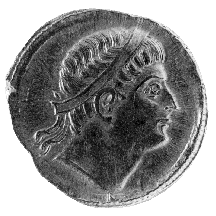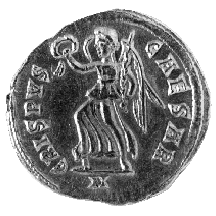



(127) Crispus - AV solidus, A.D. 325-326, 4.40 g. (inv. 91.242).
Obverse: Diademed head of Crispus r.
Reverse: Victoria advancing l., holding wreath in r. and
palm branch in l.; CRISPVS CAESAR: Crispus Caesar; in exergue, N, symbol
of the mint at Nicomedia.
Provenance: Münzen und Medaillen, 1987.
Bibliography: P.M. Bruun, The Roman Imperial Coinage
VII: Constantine and Licinius A.D. 313-337 (London 1966) 618 no. 110.
Flavius Julius Crispus, the eldest son of Constantine the Great and his
concubine, Minervina, was made Caesar in A.D. 316, together with his half-brother,
Constantine II. He was made governor of Gaul, where he defeated the Germans,
and he headed the successful naval campaign against Constantine's rival,
Licinius. He was executed in A.D. 326, apparently amid accusations of adultery
with his step-mother, Fausta.
The early coin portraits of Crispus emphasize his military successes by
depicting him armed, and the Victory on the reverse of this coin probably
also alludes to these achievements, but later a new portrait style, a diademed
head with an upward gaze, appears on his coins. The head of this coin and
the type of the reverse are almost identical to the types on contemporary
coins of Constantine, and the similarities were probably meant to strengthen
Crispus' position as an heir to the throne.
J.D.G.



All contents copyright (c) 1996.
Lawrence University
All rights reserved.